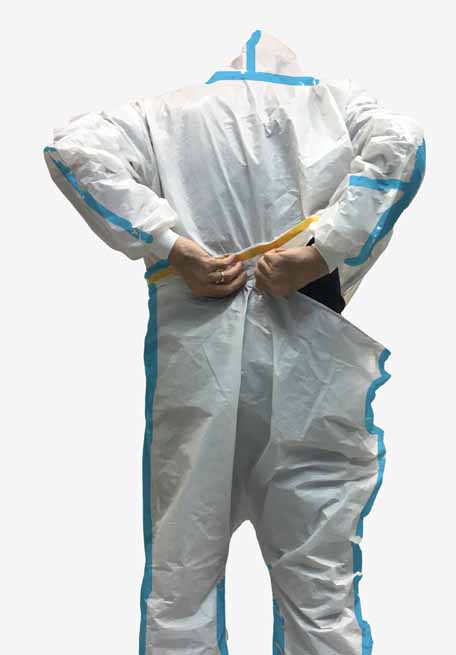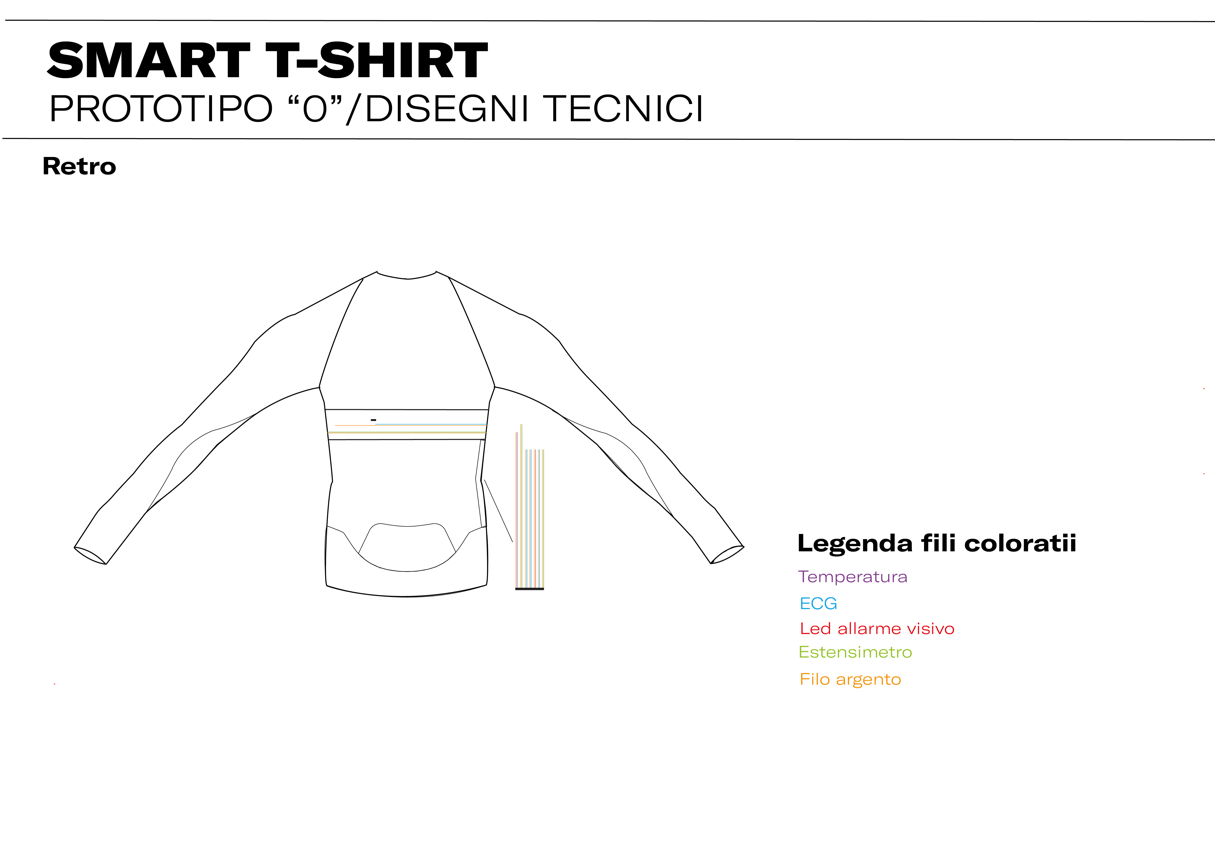1. Scenario
The Coronavirus-19 pandemic crisis, which manifested itself in Europe at the beginning of 2020, has determined a concrete shift in the line between what is useful to do in the immediate term to respond to the sudden appearance of an emergency, in this case of a sanitary nature, and on the other hand, what could be done in a medium- or long-term perspective. The considerations on the duration of the initiatives to be undertaken, in terms of evaluations of the responses on the immediate benefits, obtainable to face certain criticalities, and those in the medium or long term to be disposed, which concern the sudden change of ways of life, lead to assume a historical perspective on the real caesura in act; a binomial that sees the opposition between possibilities and limitations, more and more unbalanced. Compromises, adaptations, limitations, forecasts, confinements, terms that arise to characterize the actuality, qualify the state of emergency, while capturing the deep sense of the challenge to which we are urged to respond and for which to derive gestures and behaviors consequent and sharable.
The same productive systems that operate locally have proven impact on ecosystems, triggering irreversible processes, whose effects spread elsewhere, putting the global balance at risk. In this scenario of unconditional confidence in innovation, especially technological innovation, a sort of absence of technological protection is affirmed, so that a more natural rhythm is imposed.
From the call to arms to the immediate resolution of the health emergency, while reflecting a system in which the short-circuit is due to circumstances not foreseeable by the dominant modernist logic. The intemperance of human doing, the result of excessive rhythms, has determined for a long time the absence of restorative actions or the search for solutions to the effects on ecosystems, causing a void in terms of responses on the implementation of sustainable perspectives, whether they are preventive or defined solutions for human health. The occurrence of unexpected and unresearched phenomena such as emergencies, and in parallel the response, equally unexpected, of the ability of natural systems to resume their rhythm, time and space lost, represent the superficiality of human action and therefore the need to draw from different areas in order to have what it takes to contain this virus. Design as a mediator to emergency problems is the main theme.
1.1. Reacting to an emergency call
The article collects the results obtained following the elaboration of the research project funded by the Campania Region, "Smart&Safe. Design for new Individual Protection Devices" submitted to the call for the acquisition of research and development services for the fight against Covid-19, constituting a substantial study of the issues related to health emergency, compared to existing protocols related to individual protection systems. The research proposes an update in the redesign of individual Personal Protective Equipment (PPE), in order to explore a new dimension of the project that highlights the transition to an Intelligent Individual Protection System (IIPS) and therefore plural with the aim of relaunching reflection on the contents related to the various levels of safety to be implemented during health emergencies, thanks to the development of solutions for the use of the devices themselves that determine a relational system of integrated protection. In addition, the reflection goes in the direction of the development of advanced performance of the devices; able to implement an application field based on human experience, it is ready for human-device interaction, implementing a multifunctional and shared protection dynamic. The Campania Region, in line with national governance, has therefore established the Regional Crisis Unit for the implementation of activities, to be removed under the provision of the Head of the Department of Civil Protection of March 3, 2020, with the obligation to carry out the activities arranged, at the regional level, by the operational measures of civil protection already adopted and promptly reporting to the President of the Regional Council of Campania any need or issue relevant to the evaluations and determinations. In line with the European states that have emerged to deal with the Coronavirus emergency, the Region has redefined a specific funding framework to immediately identify proposals for innovative scientific and technological solutions to help treat, test, monitor or contribute in any way and in the shortest possible time to counter the serious health emergency caused by the Covid-19 pandemic. These solutions, which include validation and prototype testing, are intended to increase the functionality of existing products and services or create new ones.
The definition of a categorization of the themes of interest and the ranking of priorities defines the eligibility of the proposals submitted for evaluation by the technical-scientific referents identified by the Region. The thematic areas identified cover a wide range of interventions, from epidemiological, screening, assistance, epidemiological risk prevention, to vaccine discovery. The evaluation of the expressions of interest received, related to the research projects presented, approved on the basis of quantitative and qualitative criteria, has established that the research project presented, entitled "Smart & Safe. Design for new personal protective equipment", is approved for funding in the category "Improving epidemiology and public health" with priority 1.
2. Smart&Safe. Developing a personal protective equipment
The “Research and Development Proposal. Design for new Personal Protective Equipment (PPE)” is articulated in the design and prototyping of several types of PPE gowns, coveralls and T-Shirt with smart and wearable equipment for the safety and security of the operator in the workplace of work.1 Through a system of control and diagnostics for the prevention and assessment of risk assessment, an "Active Safety System" is set up. The Personal Protective Equipment (PPE) understood in its current meaning, becomes an Intelligent and Individual Protection System (IIPS) defined according to the differentiation of the different layers that make up the final unitary configuration of the system unitary final configuration of the system. The Intelligent Individual Protection System is composed of different layers which, starting from the outermost one, are distinguished in the following parts to each of which is entrusted with a performance and a functionality ensuring: the primary protection (integral suit) the secondary protection (USCA smock); the advanced protection (smart T-Shirt) with wearable add-on in terms of wearable add-on in terms of control and diagnostics of the health worker.
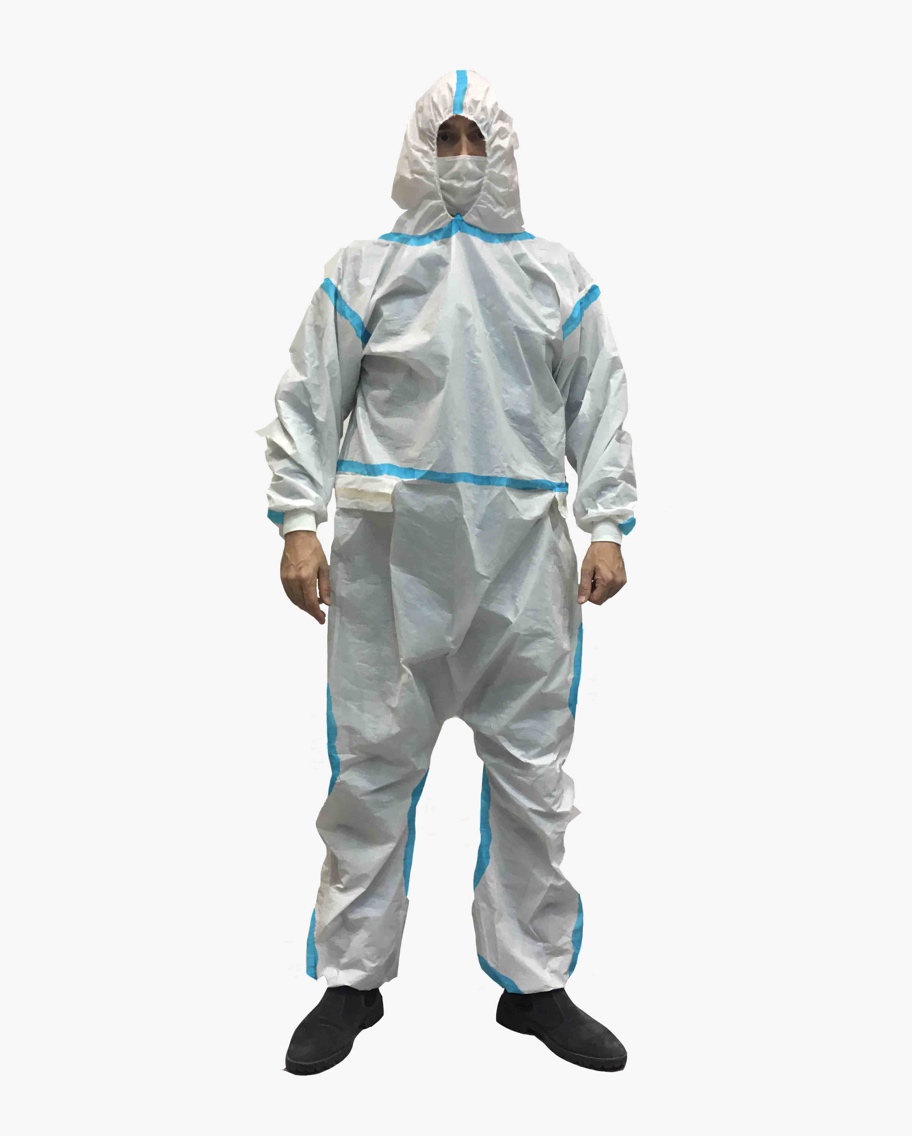
Fig. 1 Smart&Safe PPE prototype. PPE taped full body suit. Executive design prototype “0”. Source: Smart&Safe Project, 2020
PPE is defined as any equipment intended to be worn and held by the worker to protect him or her from one or more risks that may threaten safety or health during work, as well as any complement or accessory intended for this purpose (Article 74 paragraph 1 - Legislative Decree 9 April 2008, n. 81). The first category (simple design, intended to protect minor offensive actions, e.g.: sunglasses) and the second relating to all PPE that do not fall into the first and third categories intended for protection at work - enter the 3rd category as follows: "this is PPE of complex design intended to safeguard against the risk of death or serious injury of a permanent nature. To this end, PPE in this category must be appropriate and balanced in relation to the risk; chosen wisely; properly worn and removed; safely disposed of". In the "Technical Document on Protective Measures for Health Protection in the Transport and Out-of-Hospital Management of Patients" Infected or Potentially Infected with Class IV Biological Agents "(December 7, 2015) it is stated that PPE for the management of highly contagious include the following items of clothing: shoe covers or boots; water-resistant coveralls or waterproof gowns; FFP3 - full face masks; goggles; waterproof apron; double pair of gloves. PPE must be worn before encountering suspected infectious or infected patients. Proper procedures for putting on and taking off these devices include: first pair of gloves, waterproof gown, cap, filter mask, protective eye visor, second pair of gloves and must be put on and then taken off safely, time and action. Health care workers must be extremely careful when donning and doffing protective gear to avoid self-contamination. In safety principles for PPE donning/doffing there is still no gold standard, to this end, clothing that is easy to put on and take off is suggested, accompanied by a written procedure and accompanied by pictures. Good behavioral rules suggest the following: when putting on PPE, hand hygiene should be performed before putting on new gloves; when removing PPE, care should be taken to avoid any contact with contaminated PPE, do not reuse disposable PPE, decontaminate goggles, non-disposable face shields. International scientific research clearly demonstrates that the removal phase of contaminated PPE often involves self-contamination by operators. An estimate of the degree of contamination during the removal of PPE used for Ebola was carried out by the University School of Medicine of Seoul (South Korea) on operators with work experience (about 3 years). The research has highlighted several critical issues: during the experiment 65 cases of contamination occurred (2.2 incidents/person); the greatest vulnerability occurs with the removal of respirators (79.2%); the removal of shoe covers records 65.5% contamination; while 41.3% in the removal of the hood. The most frequent site of contamination is the neck, foot, and head area when not covered by a full coverall. In addition, the PPE removal phase must be performed with extreme care, since the external parts and especially the front parts of the PPE, are likely to be more contaminated than the rear parts and the top of the head, therefore, it is necessary to avoid touching the front part when undressing and more generally all external parts. To confirm this, in the undressing procedure, the PPE suit should be turned upside down, as should the gloves, and confined in a container for safe disposal. PPE donning times (195-266 s), higher than removal times (154-209 s), influenced by the donning/undressing steps of the coveralls (approximately 50 s), boot/shoe covers (approximately 40 s), and gloves (approximately 30 s).
3. Methodology. Human-centered design and usability
The theme of technical and functional clothing design cannot ignore the methodology of Human-Centered Design that refers to the ISO Standard providing guidance and requirements in the interaction between man and machine (computer). Attention is focused on part 210 of the standard that establishes the guidelines to be followed for a design that focuses on the person with a whole series of requirements [ISO9241]. The user experience is based on learning, acquiring, and knowing a given device,2 then its abilities and limitations and actual usefulness. The design must consider not only the aspects related to the product and the user's response, but the whole system of activities concerning the organization of the team of developers [UED04].
The honeycomb schema (User Experience Honeycomb) by Peter Morville,3 president of Semantic Studios, specifies the user experience defined by seven juxtaposed hexagons, each representing:
usefulness: you must not stop at the initial design; you must implement it to make it more useful and innovative in relation to the user to whom it is addressed;
usability: this is an important criterion in user interface design methods (for computer systems) as for all other products, but not sufficient to determine the entire user experience.
desirability: it explicitly concerns the sphere of emotions that the power of the device provokes in the user, conveyed by the aesthetic quality (image) and the reputation of the brand.
findability: it is necessary to design systems and products in which users can find what they are looking for with ease and transparency.
accessibility: design for all is aimed at categories that express special needs (Papanek, 1973), i.e., those with disabilities (more than 10% of the population), it is necessary to make technology accessible to all, so that they can use it and use it as a potential vehicle to eliminate existing barriers;4
credibility: this represents an important lever to better explicate the design tools that decisively influence credibility on the part of users.
value: the products that are developed must be part of the value chain for those who produce and for the group of users for whom they are intended, increasing customer satisfaction [UED04].
ISO 9241-210 updates in content, criteria, and method the previous ISO 13407:1999, the main points are:
clarify the concept of iteration throughout the design phase;
emphasize, in the design method, the central role of the user that informs the entire design process;
explain and make transparent design activities;
clarify the principles of user-centered design [ISO9241].
Part 210 of ISO 9241 is concerned with providing a set of rules and requirements consistent with the principles of human-centered design throughout the life cycle of interactive systems. Human-centered design refers to a method of developing interactive systems that aim to produce a computer system that is useful and usable to the user and that covers the user's needs and requirements. The use of a human-centered approach to development benefits everyone who is in close contact with the product, from developers to users. Highly usable systems are more understandable to users, who are inclined to spend more to have a product or service that represents the outcome of good design before being commercialized; moreover, user support services will cost less to companies, as users will be able to understand how to use devices or software without further specification. Following the human-centered approach, moreover, the quality of the final product-service improves considerably through a series of considerations that concern the user-machine or service relationship in terms of productivity; the ease of use that allows a wide use and cost reduction; the accessibility in the social field; the improvement of the user experience and therefore of the skills or capabilities; Increased product knowledge and consequently the efficiency of the organizations that use it; reduced stress and discomfort for those who use it out of necessity; increased reputation and image of the production brand; achievement of sustainability goals centered on the user experience of a community of users.
In addition, the use of appropriate methods of human-centered design of a product or a service reduces the risk of failure in achieving the requirements and performance demanded by companies and clients, vice versa the rejection of the acquisition by users based on the market to which it is addressed. According to ISO 9241-210, good design is based on knowledge of the environment in which the product under development will operate, the functions and performance it will perform, and the target or type of user for whom it is being developed. The project and its process must consider the following elements: for whom it is designed (client); by whom it is used; but also, by those who, directly or indirectly, are affected by its implementation; for UNI a reason for failure of a product or service, of which an inappropriate design approach, depends on neglecting or not taking due account of one or more of these factors. When designing a product-service, it is also necessary to always keep in mind that users do not have the same goals nor the same ways of using devices, nor the same operations, depending on a specific field of action. The most fitting example is related to the user interface, in the case of a young person it could be completely inappropriate on a smartphone if used in a working context; in both cases the personalization of the contents is a key factor, operated in extremely different ways. Therefore, it is fundamental, during the design of a service or a product, the behavioral analysis of the characteristics of the user (final consumer or client company), without underestimating the functionality it must have and the physical environment of use. These three pieces of information are called the context of use. Another central point of ISO 9241-210 is related to the design of a good product, indispensable is the active involvement of the end user during all phases of creation. Users must be chosen so that they represent a meaningful sample for the use of the product or service, and they provide relevant requirements and feedback to the product that may turn out to be suggestions or proposals to make changes and improvements to the initial design. Development therefore not only puts the user at the center, but even, from the beginning to the end of the process, includes the point of view of those who will use the product.
The information that users formulate about the product will be vital to its success, and because their suggestions facilitate improvements, users will benefit from a product that is tailored to their needs. This process of human-centered development follows the logic of iteration, that is, it is based on the repetition of a whole series of steps until the desired result is achieved. The repetition of all the steps ranging from development to user testing, to the receipt of feedback that follows, to the application of changes once they have been evaluated and the re-submission to users until the result is not achieved, means that step by step, progressively the various uncertainties about the project are eliminated during development and the result achieved, continuously revisited is ad hoc for users and will meet every request.
4. From user experience (UX) to collaborative user experience (CUX)
The sphere of User Experience (UX) according to the ISO standard encompasses not the direct user experience of the product itself and as an end but involves a broad sphere of everything about the use of the device. Donald Norman,5 states that the design of products and services pertains to the emotional sphere in "Emotional Design" states that people have three levels of processing while using any object. The first level is called visceral - represents the automatic reaction that is established between the user as soon as an object appears in his sight. It is a completely automatic level of reaction and the user expresses a judgment in relation to the degree of acceptance that the object provokes (whether they like it or not), the degree of interest (boring or fun). The emotions according to Norman are therefore to the center of the attention of the designer and include: the behavioral level that describes the effective use effective use of a tool and therefore the sensation provoked in the user in feeling pleasure or not from the use of a device in view of the desired result.
The second level is called reflexive - it has nothing to do with the aspect of effectiveness but rather. The second level is called reflexive - it has nothing to do with the aspect of efficacy, but gathers everything that gives rise to positive memories during the use of a product such as a sense of satisfaction and accomplishment in use. Marc Hassenzhal,6 Professor of Experience and Interaction at the University of Siegen, has always been interested in the design of user experience, defines aspects not related exclusively to productivity but of pragmatic objectives that concern the user's desire to "do", while the latter of "being", referring to the effectiveness and efficiency of a product or service, and more personal dynamics.
The design of a service or a product with a human-centered development, therefore, takes into account to take care and design from the user's point of view not only the product, but also its paper documentation, through which the user learns to use at best what is created, which is composed of an on-line user support, reachable in case of any eventuality; the assistance and maintenance service, which has to take care of helping the user in case of various inefficiencies caused by the product; if necessary, a training phase to guide future users in its use; the design of the container, inside which the finished product will be inserted; all the accessories and related documentation. As described, the product development team following the human-centered design approach is composed of members from different areas of knowledge and scientific fields and are based on the following requirements: the relationship between humans and usability, accessibility, and human-machine interactions; the users or organizations that will use the product; the context of use in which the product or service will operate; sales, marketing, user safety aspects; and support and maintenance engineers; the user interface and other visual aspects; user manuals, training, and user support; user, service, and business management; systems and business analysts; hardware and software systems, programming, manufacturing/manufacturing, and maintenance.
The project will focus on Human-Centered Design planning.
The key concept is that this type of design and development is planned and integrated at every stage of its progress, from conception through testing and maintenance the project includes planning for all ergonomic factors by assessing how the usability of the product or service changes based on the number of users, the environment in which it operates, its relationship to other systems, or represents a user safety issue; how the levels of various types of risk can result from poor usability; what influence the type of development environment has. In general, then, it can be said that the intent is to identify appropriate methods to reduce the risks of user interaction with products, services, and systems as much as possible. The design of a user-centered product or service must therefore be planned;7 the time required to create the product must be estimated, taking time to evaluate user feedback and understand whether the resulting outcome meets the requirements set by the project.
The additional time required to identify and resolve usability issues in the early stages of design must also be considered as it involves a reassessment in terms of cost. In the hypothesis, therefore, of more actors and factors involved, the Collaborative User Experience (CUX) to develop a product or a system of products, follows the footsteps of user-centered design, taking the following steps understanding and defining the context in which the product or service being developed will operate; specifying the requirements of the collaborating users and the reference organization; evaluating the project and the service already existing and operating to implement it from the point of view of the performance of the product and especially the service extended to the community, considering that there will be multiple users8 or organizations with different needs, and the context of use will vary depending on who will use the product, how many will use it and the service system connected.
5. Performative-suit design. Wearable monitoring systems
Performative-Suit Design considers wearable devices as a means of stimulating discussion and debate among designers, industry, and the public about the social, cultural, and ethical implications that exist about the use of emerging technologies. Focused on experimentation, the application of textile (and non-textile) materials and wearable technologies, it relates to areas of human activity that require specialized, performative clothing, a type of functional clothing. Creations that foster new abilities, equipped with sensors that perceive and interact to changing environmental conditions, transforming themselves developments of the human in relation to new technologies and the Internet of Things (IoT), triggers a series of questions about the dimension of the future body.
Objects evolve, it is assumed that they will develop an internal relational system, in short, they will communicate with each other, interacting to organize activities in autonomy in a relationship of reciprocity and symbiosis. Faced with these challenges, the body and beauty lose their original charge, we look to the future by pushing the limits of the human towards a design of the self against the conventional schemes. Software to "animate" them guarantees the functioning of a living organism, because they establish a relational dialogue with the contexts of life.
The next frontier sees relational objects designed for this purpose since the materials and smart components of which they are composed and from which they are generated; the "informed" matter the so-called STEM Materials, Sustainable Transformative Engineered Multi-functional.9 STEM Materials are considered as possible enablers for solutions that respond to many social and especially global challenges (Moretti et al., 2019). A generation of materials capable of providing heterogeneous responses related to multi-functionality. These materials systems are called "stem" materials, in analogy to living cells where a base of primitive units can be designed and assembled to self-react to external inputs. STEM Materials will incorporate an "Internet of Things" (IoT) concept, where their processing capability will allow systems to interact with the environment and express various functionalities.
STEM Materials do not yet exist, but many clues from various theoretical and experimental results suggest that they can be developed because there are living organisms that inspire them. In the prediction of the project Smart&Safe the creation of a PPE System with smart and wearable equipment for monitoring the health and social worker in the workplace, is done through a system of control and diagnostics for prevention and risk assessment at work, with the configuration of an "Active Safety System". The Smart&Safe project is divided into the following phases: a path of training and practical and operational innovation on safety; the implementation of an interactive and updatable product-service system that allows to monitor physiological parameters and to intervene on risk factors directly on operators, thanks to the possibilities offered by the "active safety" systems; the future forecast foresees the configuration of a product-service system connected to a network for the sharing of medical records.
The objective of creating innovative products and services in the field of PPE safety has a significant impact on the behavior of those working in the field. Creating PPE equipped with systems that interact with the user means equipping them with smart and wearable devices that can learn from experience and prevent risks and recognize emergencies. PPEs form a system that contains a smart element: a smart T-Shirt able to scan the physiological parameters of the individual worker. The provision of recording devices, and data retrieval, triggers the corresponding corrective and/or investigative and protective mechanisms. The Individual and Intelligent Protection System (IIPS), which dialogues with the user and the surrounding environment and guides him in safety, is -configured as an element of the Product-Service System that guarantees reliability both for the wearer and for managing safety in the workplace.10 The SPII thus conceived is the terminal of the interactive, reliable, and safe Product-Service System, with various degrees of performativity thanks to sensors positioned in contact with the body and with the outside world to monitor personal and environmental data that will be appropriately processed to implement prevention and control measures.
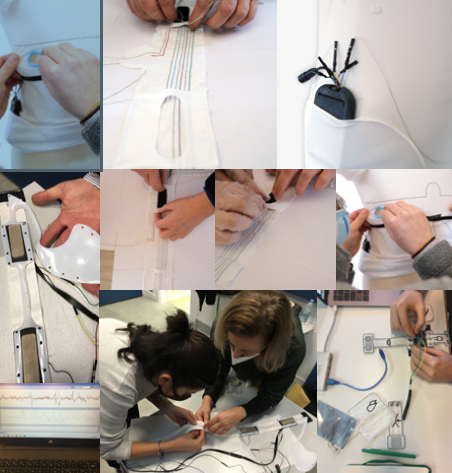
Fig. 3 Smart&Safe research stages. Approach to active protection system configuration. First stages of research and development: relationship between jersey and advanced materials; study of electronic circuits and positioning data acquisition card; collaborative experience with teams of experts (doctors, electronic engineers, designers, textile designers, graphic designers). Source: Smart&Safe Project, 2020
6. Smart&Safe: The project planning
The Research and Development proposal "Smart&Safe. Design for new personal protective equipment (PPE) "is divided into the design and prototyping of several types of PPE shirts, overalls and T-Shirts with smart and wearable equipment for safety and protection of the operator in the workplace.11 Through control and diagnostic system for risk prevention and assessment, an "Active Safety System" is configured. The PPE understood in the current sense, therefore becomes na Individual and Intelligent Protection System (IIPS) defined based on the differentiation of the different layers that make up the final unitary configuration of the system. it consists of several layers that starting from the outermost one is distinguished in the following parts to each of which is entrusted with performance and functionality ensuring: primary protection (full suit); secondary protection (USCA gown); advanced protection (smart T-Shirt) with wearable add-on equipment in terms of control and diagnostics of the healthcare worker. The SPII will respond to different needs, identified as follows:
1 - PPE USCA shirts. The Local Health Authorities have activated the establishment of the Special Continuity Care Units (USCA) which, in line with the guidelines of the regional government, with mobile units (task forces) and doctors will carry out active surveillance activities through the administration of tampons at home to suspicious patients and to those who have completed the quarantine period and for whom recovery must be certified. To this, USCA operators need, as for health workers in triages, and in the red areas inside hospitals, of PPE consisting of new gowns designed to facilitate dressing/undressing and disposal operations in compliance with the provisions of the law. The implementation times are to be referred to the very short term (WP1, WP2);
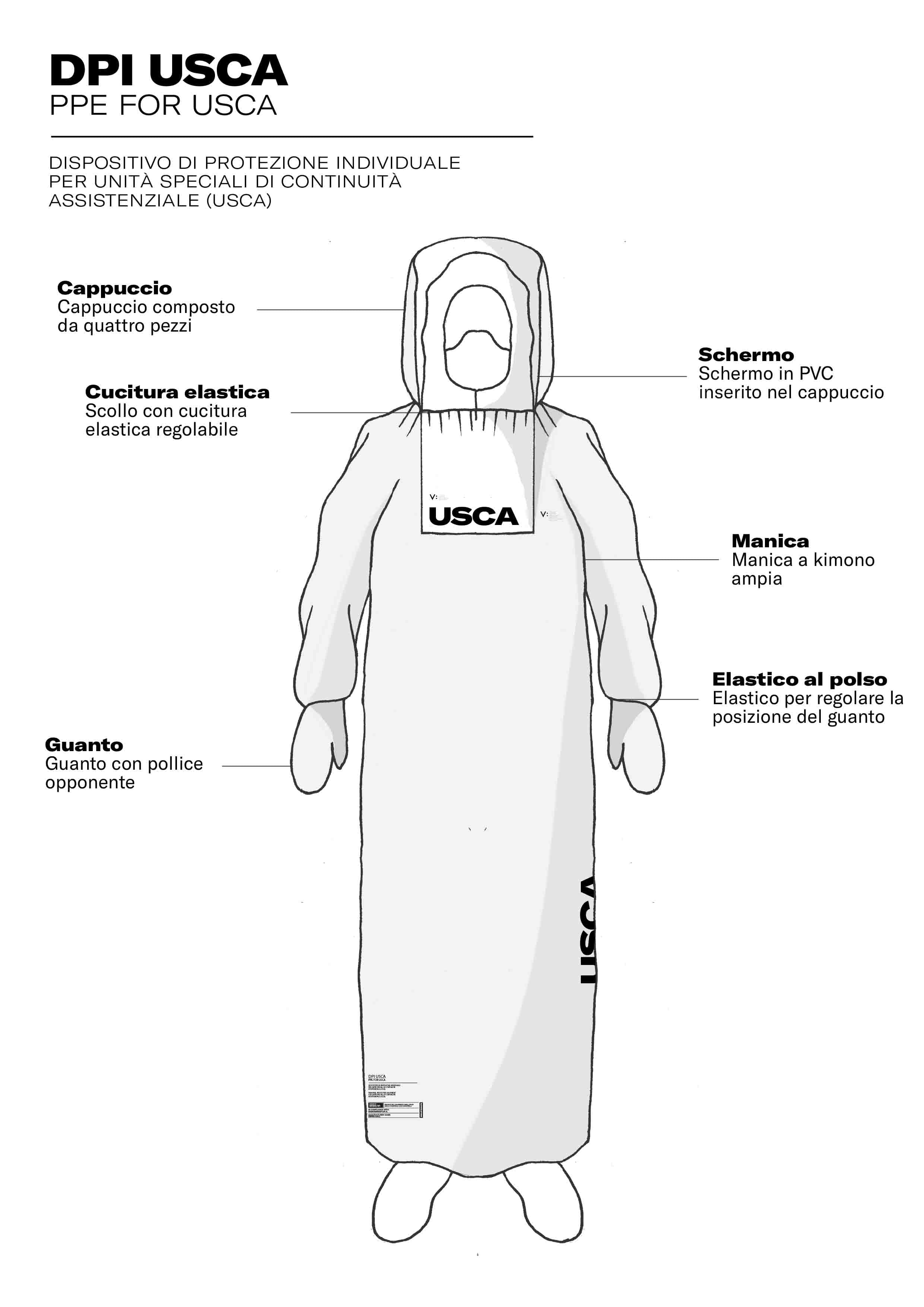
Fig. 4 Smart&Safe PPE for USCA, technical drawing. Technical drawing front and back SCCU gown Personal Protective Equipment for Special Care Continuity Units (SCCU). Source: Smart&Safe Project, 2020
2 - PPE full suit for triage and hospital environments. The premises, relating to the 3rd category as it can be seen from Legislative Decree 4.12.1992, n. 475, and the “Technical Document” of (7 December 2015), provide the technical-legislative references for the re-design of PPE made up of new full suits designed to facilitate dressing/undressing and disposal operations. Implementation times are to be referred to in the short term (WP3, WP4);
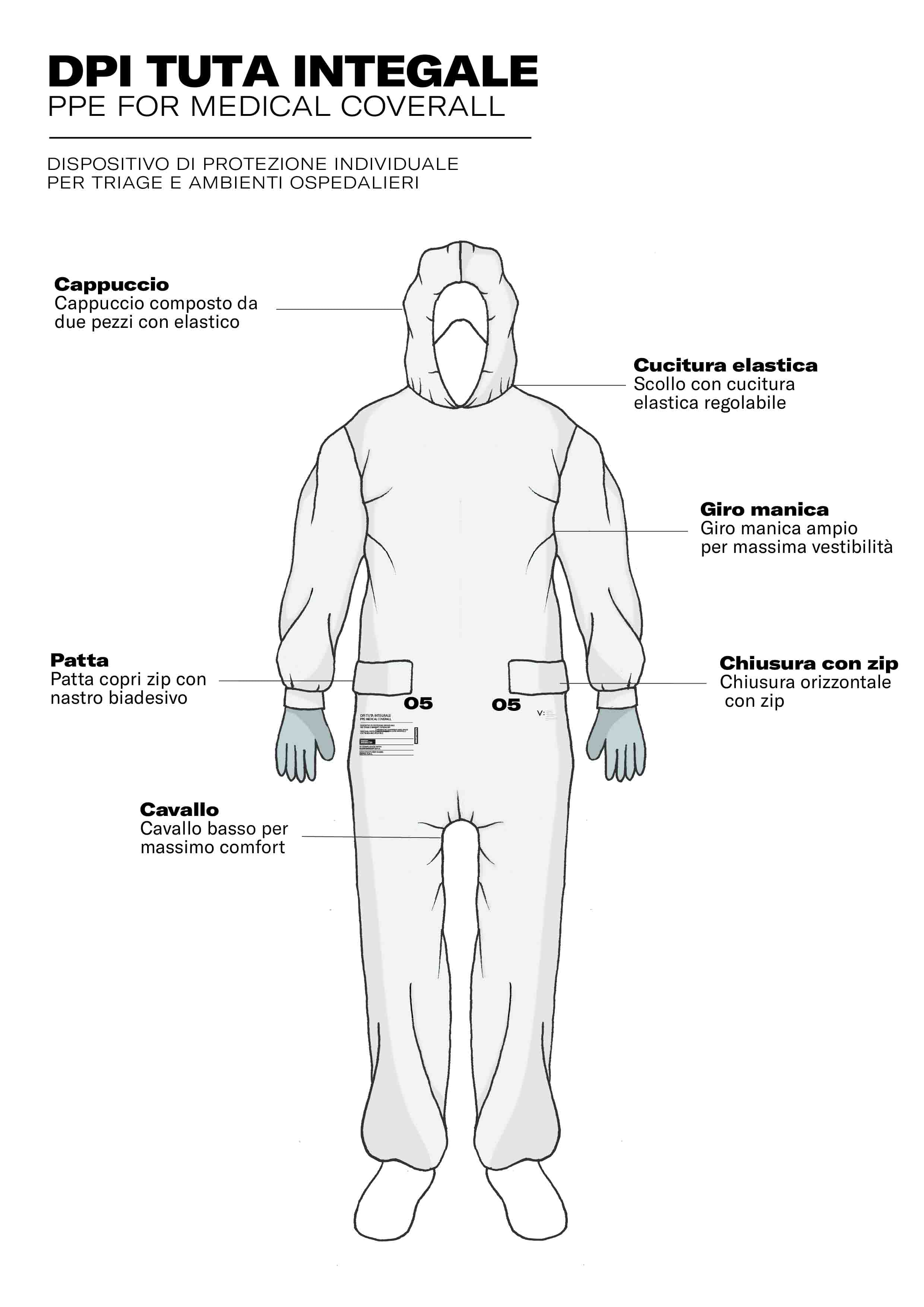
Fig. 5 Smart&Safe PPE full suit technical drawing. Technical drawing of PPE full body suit for triage and hospital environments. Source: Smart&Safe Project, 2020
3 - Smart T-Shirt with smart equipment and wearable add-on. The “Active Safety System” is the design of a wearable add-on T-Shirt. The smart T-Shirt integrates a smart device capable of measuring the physiological parameters of the individual healthcare worker during their stay in the ward. The wearable equipment works as a physiological data detection and measurement device. The implementation times refer to the medium term.
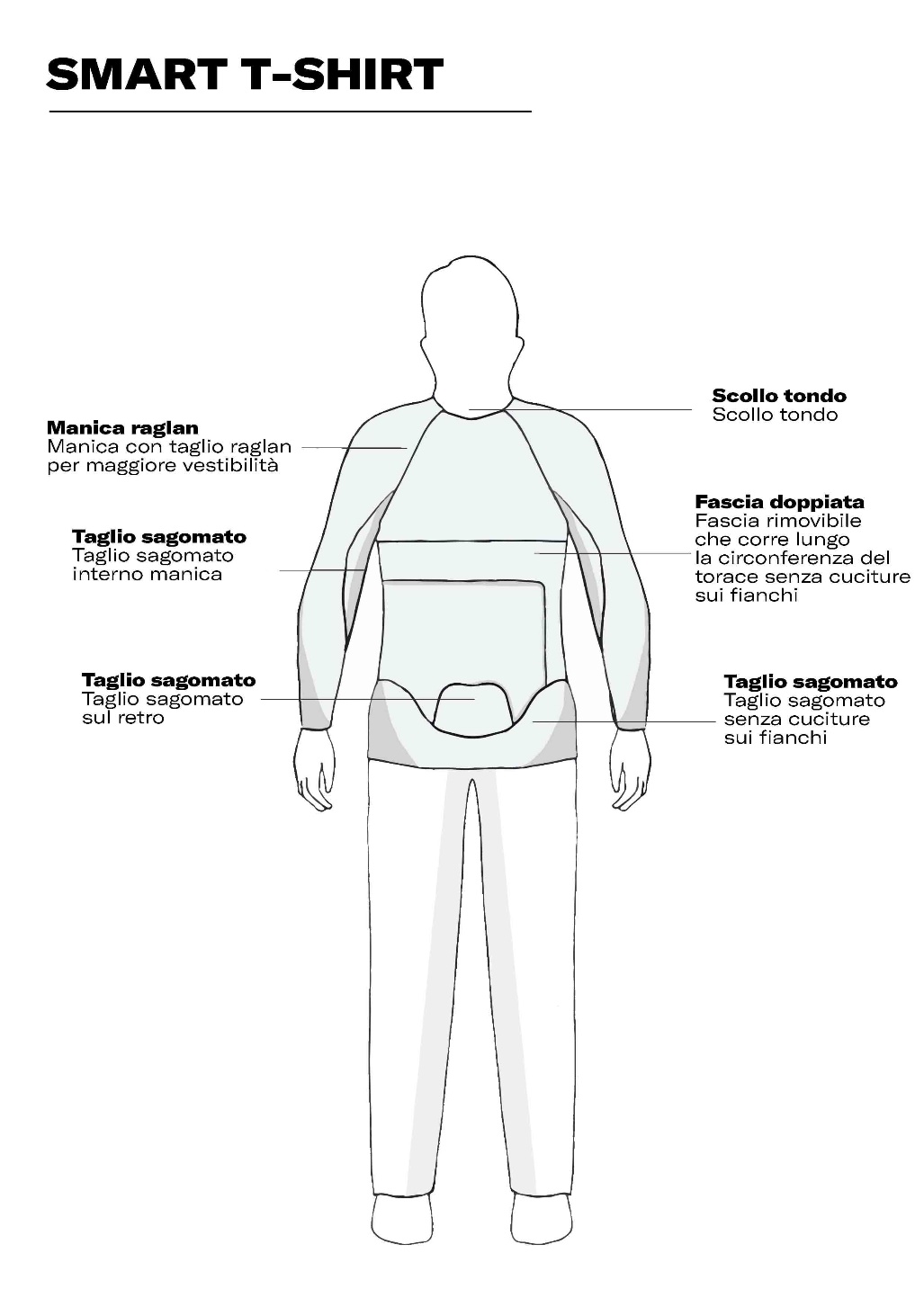
Fig. 6 Smart&Safe Smart T-shirt, technical drawing. Technical drawing front of wearable add-on Smart T-Shirt that integrates the Active Safety System. Source: Smart&Safe Project, 2020
6.1. Textile Design
In the design of the Smart T-Shirt, the Work Dress Design methodology was adopted, that is, the design phases relating to the different functional and performative degrees designed in response to the user's needs were developed on the T-Shirt garment. The Work Dress Design methodology consists of three phases of conception and design of the garment, divided as follows: Commodity, Utility and Facility.
The garment was designed starting from the conception that in the first stage of use it must meet the Commodity requirement, the design, therefore, considers the clothing structure in layers or functional zones in consideration of the fit and ease of use.12 The body mapping detected and consequent to the actions of the users (socio-health personnel) in the performance of the work practice, distinguishes the adaptive areas (areas of the body with dense muscle masses), from the collaborative areas (areas of the connecting body) to the exposed areas (areas of the body that are vehicles of contagion).
The second stage of design refers to the concept of Utility, that is, to the design that is embodied in typological innovation and the communicative component.
The latter incorporates the needs of the utilitarian component and, as a means that is ready to summarize the requirements of ease of use, fit and smart equipment, it assumes the role of a communication tool for users and the community. wide of users. The T-Shirt is designed to accommodate areas that describe its usefulness through a multi-chromatic graphic code that summarizes the different functions and degrees of performance that the T-Shirt is equipped with. The Utility component is reflected in the design of the packaging which, together with the T-Shirt, forms a single means to contain and dispose of, after use it is confined to the same pack in total safety.
The third stage of the design is identified with the concept of Facility, in this phase, the body mapping developed in the Commodity stage, as well as orienting the modelling of the T-Shirt, prepares a series of elements for measuring the vital parameters of the socio-healthy operator - rate for monitoring in the workplace. The creation of the Smart T-Shirt and the system that interacts with the user involves a human-centred approach for the design of smart and wearable components that can learn from experience and prevent risks, recognizing emergencies. The Smart T-Shirt, in fact, able to scan the physiological parameters, of a single employee has a set of measuring devices and data retrieval. The Facility system that communicates with the user and the surrounding environment and guides him safely, is configured as an element of the smart and wearable that guarantees reliability both for the wearer and in ensuring and managing safety in the workplace. The Smart T-Shirt thus conceived represents the terminal of the interactive, reliable, and safe product-service system, with various degrees of performance thanks to sensors positioned in contact with the body and with the outside, for monitoring personal data and environmental data that will be suitably processed to implement prevention and control measures. In anticipation of the Smart & Safe Project, the creation of a PPE system with smart and wearable equipment for monitoring the socio-health operator in the workplace (Tsao, 2020), takes place through control and diagnostic system for the prevention and assessment of risk at work, with the configuration of an "Active Safety System" of which the typological and textile design of a Smart T-Shirt is part.13
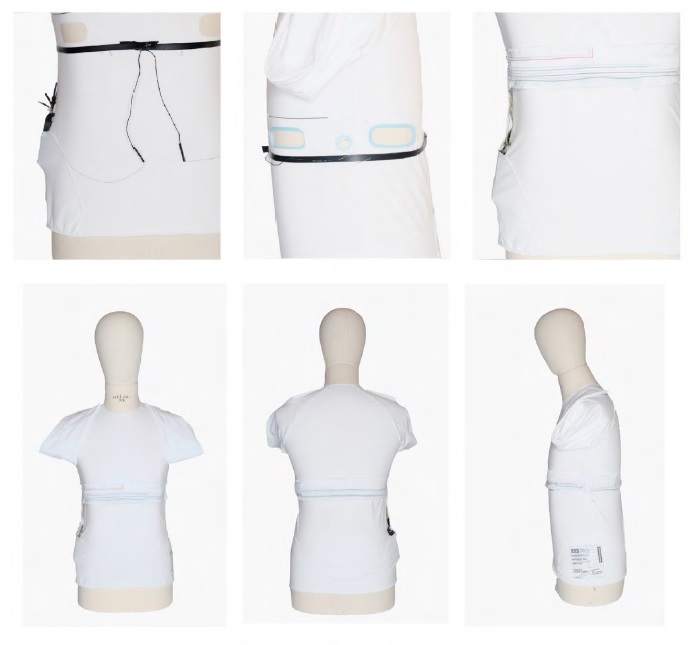
Fig. 7 Smart&Safe Smart T-shirt, details. Focus on wearable add-on Smart T-Shirt. Focus on arrangement of conductive yarns by color and type of sensor connection; study of electronics components to operation and monitoring of vital parameters. Source: Smart&Safe Project, 2020
The Individual and Intelligent Protection System (IIPS), therefore, through the Smart T-Shirt is equipped with an "alarm fatigue": worn as a base layer in contact with the skin, the Smart T-Shirt detects fatigue and work-related stress affecting engaged social and health workers in the activities of high intensity of care and the medium-low. Activities where high percentages of false alarms are often generated, the management of which adds to the enormous workloads that operators in these departments have to bear. In terms of design, the adaptive zones correspond to flexible body areas, the collaborative zones correspond to the containing body areas, the exposed zones correspond to the body areas to be protected. The study of the body mapping thus characterized is followed by the research of materials and the typological configuration designed helps to position the different textile and non-textile materials.14 The design guidelines adopted in the various stages of design are as follows:
aesthetics: everything related to the judgment of the appearance of the shape and its functions must be associated with its level of attractiveness;
comfort: after a short time, users get used to the device and no longer feel they are wearing it, thanks to the fact that it adapts without hindering the user's movements; in fact, it allows the user to move freely thanks to the flexible materials that compose it and the fitting or wearability;
ease of use: the user interface must be simple and immediate and must allow improving the usability level of the device;
ergonomics: the physical shape and dimensions of the device must respect the anatomical aspects of the user and adapt;
topicality: the topicality of wearables follows fashion and can greatly change the perception of the device's comfort and the user's desire. Technology must follow fashion by studying the context of use in the best possible way to integrate what is happening in the environment for which it is intended;
resistance: the worn device must be resistant to shocks that can unexpectedly and unintentionally occur, to abrasions, to temperature, to humidity, and must be able to withstand water without affecting the durability of the product;
wearability: considers the physical form of the product and its relationship with the user. To be wearable, a product must comply with most of the principles mentioned above, including comfort, availability, and aesthetics.15 Wearability is a key factor for the success of a device, in terms of user satisfaction [HFCD14].
6.2. 3D Manufacturing
The research and project activity conducted, whose objective is the creation of an Individual Protection System (SPI), took place at Officina Vanvitelli (OV), a hub and light district created within the research and development activities of the Department of Architecture and Industrial Design DADI, University of Campania “Luigi Vanvitelli”. Here the experimentation on technologies was possible thanks to the adaptation of the existing instrumentation, converted, on this occasion, to produce an SPI useful for dealing with the epidemic emergency. These technologies have constituted the tool for the rapid prototyping of design objects and their instantaneous verification, born thanks to the integration between different disciplinary fields, such as medicine, engineering, and textiles,16 which finally gave life to solutions of which they are the feasibility and compliance with the identified context needs were examined.
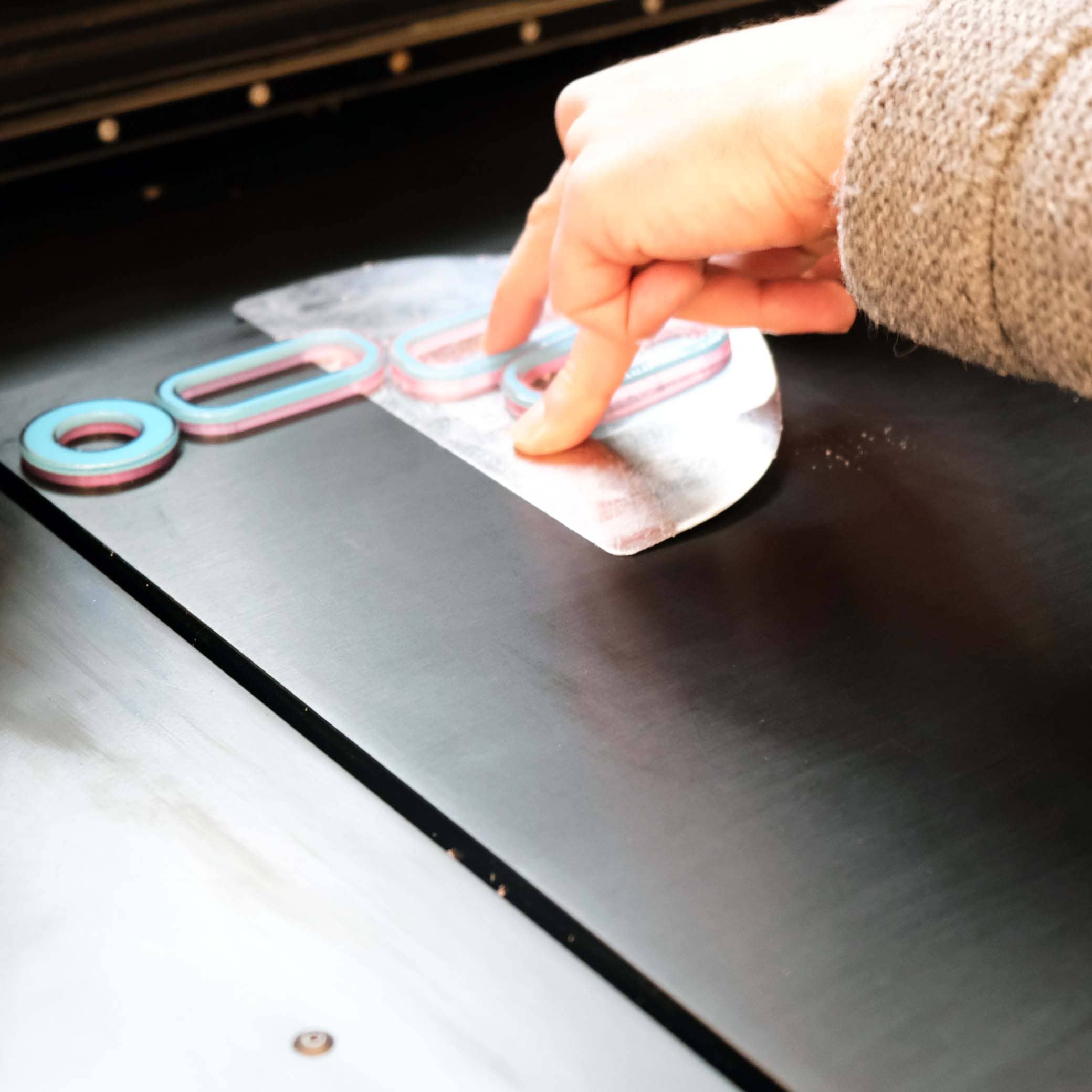
Fig. 9 3D printing process. Med610 material holes obtained from 3D printing process with Stratasys J750 designed to accommodate Smart T-Shirt sensors. Source: Smart&Safe Project, Officina Vanvitelli, 2020
The technology considered suitable for this activity was the PolyJet, which allows the
solidification through UV ray of a photopolymer material arranged by levels on the printing plate and able to produce products made up of up to a maximum of 7 different materials even at an industrial level. with a resolution of up to 14 microns.
Among the materials chosen for prototyping, Agilus30, a photopolymer like rubber and able to withstand repeated flexing and tensions, and MED610, a photopolymer material certified by the Food and Drug Administration (FDA), biocompatible, rigid and capable to offer transparency, ideal for the realization of devices with high precision and which must come into direct and prolonged contact with the skin - up to a maximum of 30 days - and with mucous membranes - up to 24 hours.
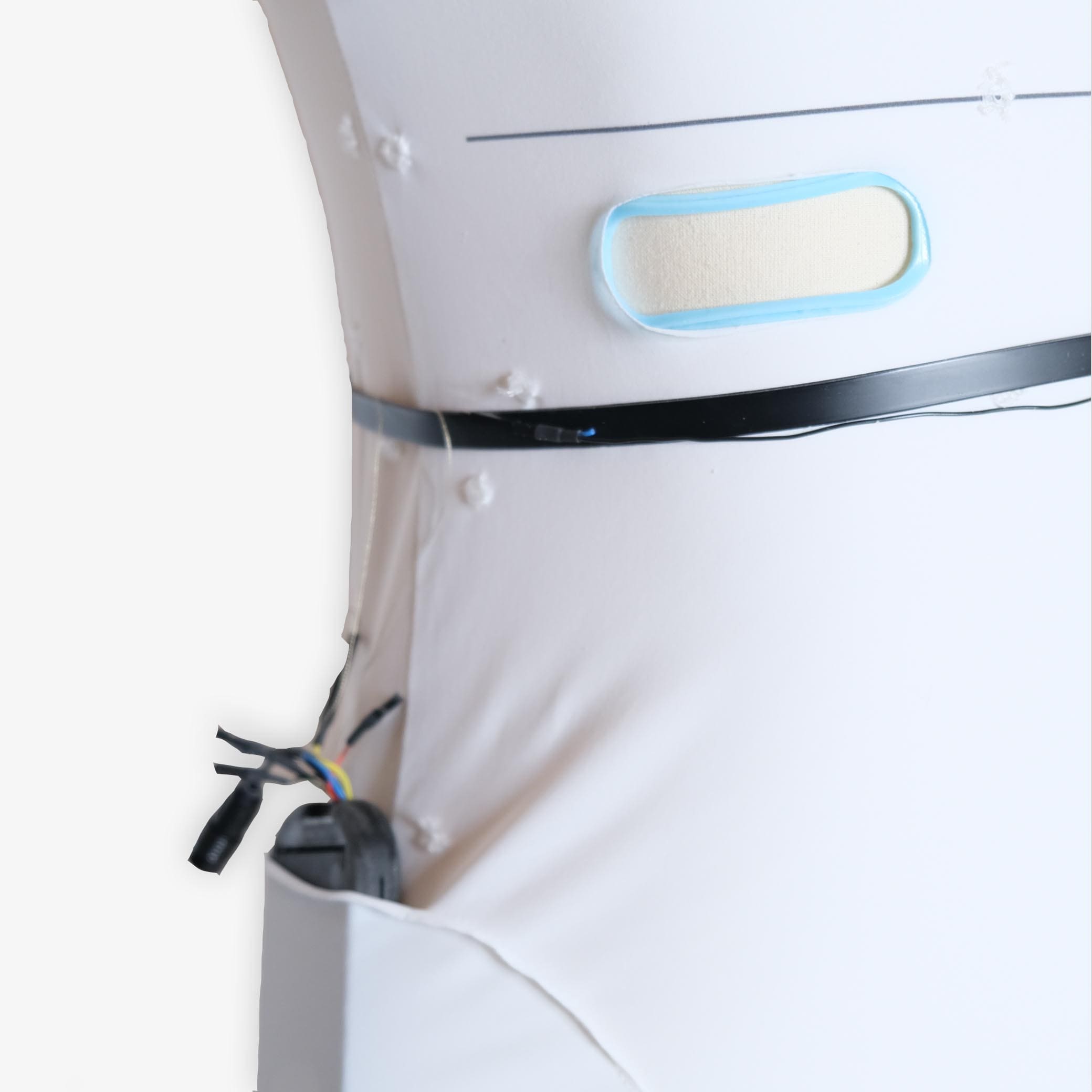
Fig. 10 Med610 material holes details. Med610 material holes details placed on Smart T-Shirt before allocating sensors. Source: Smart&Safe Project, Officina Vanvitelli, 2020
Each material has specific characteristics, strengths, and weaknesses, which require the designer to carefully analyse them, for this reason, the first experiments - as will be seen later - were conducted with Agilus, to obtain resistance. and flexibility, especially considering that the designed object is meant to be applied to the t-shirt.Once the type of system and device for the detection of biometric data, as well as the technologies and materials for the realization, had been identified, it was necessary to study its characteristics, based on which to evaluate and develop a geometry considered suitable both in terms of wearability, that of printability and assembly of the attached tools. To do this, the meta-design process was divided into several phases, each of which involved specific analyses: 1.Study of human anatomy for sensor applications: in this first phase it is necessary to understand the parts of the body that are best suited to the detection of biometric data and therefore to the positioning of biosensors in charge of this; 2. Adaptation of the geometry studied on the conformed sensor circuit: once the system of sensors necessary for the detection of data on the user's organism has been built, we moved on to the development phase of a geometry that could collect and incorporate the individual components electronic to guarantee the safety of the user but also the accuracy of the detection; 3. Comfort during use: once the first geometric shape has been developed, this has been corrected by reducing the thickness, to ensure greater comfort for the user during the period of use; 4. Enough space for additional sensors for implementation: analysis of the current dimensions and housing, to facilitate further development of the SPI and therefore allow the insertion of additional sensors; 5. Overall assessment. At the end of this first block of analysis, guided by the attempt to collect and incorporate the sensors necessary for the detection of biometric data in a wearable device characterized by reduced thickness and therefore easily wearable and with a high level of comfort, we have moved on to the more closely linked part to the design and prototyping of the SPII.
Also, this time, the process was divided into phases: 1. Realization of a cover in Agilus: the designed system was based on the use of an Arduino Uno board, connected via Jumper cables to the identified sensors, for example, the ECGs that perform an electrocardiogram on the user by measuring the electrical activity of the heart. Once the board and sensors were connected to the 9 Volt battery, the housing for the components was therefore developed to facilitate the insertion and removal of each in case the device should be washed. 2. Observation of the prototype made has highlighted some critical issues, mainly related to the overall dimensions of the device. Despite the attempt to reduce thickness - from 1.5mm to 1mm - it was clear that the problem was related to the volume of the electronics. This Observation of the prototype made has highlighted some critical issues, mainly related to the overall dimensions of the device. Despite the attempt to reduce thickness - from 1.5mm to 1mm - it was clear that the problem was related to the volume of the electronics. For this reason, the initial components were replaced with an Arduino Nano PRO board - three times smaller than the previously mentioned Arduino 1 - and, for the connections, rather jumper cables, silver wires were used that can be integrated into the fabric. further reducing the overall dimensions of the whole system. 3. Patch system in MED610 as sensor envelope: despite the work described so far, it was deemed necessary to further reduce the volume of the biometric detection system. For this reason, what at first had the shape of a belt, was divided into single patches placed punctually on the sensors. With the aim of improving the performance of this object, the patches were made with MED610, which is remembered to be a certified material suitable for direct contact with the user's skin.
7. Achievements. Individual and Intelligent Protection System (IIPS)
The research and project activity described is only part of a larger project, which is based on the convergence between different skills and disciplinary fields, to achieve a considerable advancement of the reference state of the art, as well as a response to what the field of e-health and the detection and parameterization of the quality of life of individuals. The results of the project attest the passage from the single Personal Protective Equipment (PPE) to an Individual and Intelligent Protection System (IIPS) that allows the continuous monitoring of the vital parameters of social and health care personnel and at the same time finding a significant reduction in the risk associated with professional practice, especially during the pandemic crisis.
The active prevention system aimed at a design solution, natural evolution of the Smart&Safe project, whereby doctors, nurses and patients will be connected, making the processes of prevention, treatment and monitoring more effective and efficient inside and outside the hospital.
The fatigue that affects health and social workers in the management of many monitor alarms is a problem of great relevance in hospital practice, especially in times of pandemic crisis; in fact, the intelligent component of SIPS has been found useful in detecting stress by monitoring physiological parameters and ensuring a continuous preventive action, playing an important role in reassuring the operator from prolonged damage by alarms and similar stress situations. By monitoring physiological parameters with the system connected to data storage and processing software, data is securely stored on a central server, allowing for more accurate documentation of information. This procedure is enabled, at any time and from any place to the consultation of the same by social and health operators for a more correct and timely evaluation of the clinical status. SIPS re-proposes the "fatigue alarm", through the smart T-Shirt that, worn as a base layer in contact with the skin, detects fatigue and work-related stress that affects health workers engaged in high-intensity and medium-low care. The system can also be configured to detect alarms tailored to the clinical needs of each operator, allowing a more rapid and efficient intervention in case of clinical deterioration. Clinical data collection allows a significant reduction in the time spent monitoring and transcribing data, enabling widespread and personalized prevention, process simplification, automation of monitoring activities and real-time alarm detection.
8. Conclusion. Individual and Intelligent Protection System (IIPS)
The research proposed an update in the re-design of individual Personal Protective Equipment (PPE), to explore a new dimension of the project that highlighted the transition to an Individual and Intelligent Protection System (IIPS), relaunching reflections on the various levels of safety to be considered in a critical situation; on the development of advanced performance of devices that now "interact" in a system in turn contaminated by the interactions between man, device and environment.
The overall point of view also pursued the concept of humans using design strategies helping to generate value in the "health" market, drawing from different fields, in the transformation of the health care system itself, taking an active role as change leaders along with new partners in building a safe future. With the new IIPS, design is mediating the dynamics of co-creation between user, health system and measures for care and healing, demonstrating how new technologies will shape medicine, telecare, integrated into devices that will increase functional performance for humans; User Experience will measure the degree of safety and user pleasure in use of technology, involving new actors and providing solutions for health care environments and clinical database managers. All these interactions can contribute significantly to the improvement of the quality of life, providing answers and solutions adapted to the containment of future emergencies, whether health, environmental or social.
Acknowledgements
The paper is the summary of the Research Project “Smart & Safe. Design for new personal protective equipment”, funded by the POR FESR Campania 2014-2020 program, Axis 1 "Research and Innovation" Specific objective 1.3
Principal investigator: Prof. Maria Antonietta Sbordone
With the engineering expertise: Prof. Massimiliano Masullo, Prof. Michelangelo Scorpio
The research team was attended by: Gabriele Pontillo (PhD), Barbara Pizzicato (PhD), Carmela Ilenia Amato, Alessandra De Luca.
Although the authors of the present paper shared the theoretical and research approach and the articulation of the content’s contributions are attributed as follows:
Scenario; Reacting an emergency call; Smart&Safe. Developing a Personal Protective Equipment; Methodology. Human-centred design and usability; Smart&Safe. The project planning; Achievements. Individual and Intelligent Protection System (IIPS); Conclusion. Individual and Intelligent Protection System (IIPS); are written by Maria Antonietta Sbordone;
From User Experience (UX) to Collaborative User Experience (CUX) is written by Barbara Pizzicato;
Performative-Suit Design.Wearable Monitoring Systems; is written by Carmela Ilenia Amato;
Textile Design is written by Alessandra De Luca;
3D Manufacturing is written by Gabriele Pontillo.














